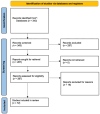Epidemiology and Screening of Developmental Dysplasia of the Hip in Europe: A Scoping Review
- PMID: 40729259
- PMCID: PMC12225343
- DOI: 10.3390/reports7010010
Epidemiology and Screening of Developmental Dysplasia of the Hip in Europe: A Scoping Review
Abstract
Developmental hip dysplasia or developmental dysplasia of the hip (DDH) includes a wide range of deformities of the hip, such as congenital dysplasia, subluxation, and dislocation. It is usually identified through neonatal screening during the first 6-8 weeks of life. The incidence of DDH ranges from 1-7% in neonates among some populations, but this may vary among different ethnicities and countries. A consensus about the ideal age for screening has not been reached to date. The aim of this study is to summarize the existing data regarding the incidence of congenital hip dysplasia and screening tests among European countries. The authors conducted a systematic search in PubMed/Medline and Scopus and collected original studies published in English, French or German. The incidence of DDH presents fluctuations, not only among European countries, but also within the same country. There is no unanimity regarding the screening methods of DDH; in some countries, universal ultrasound is proposed as the basic screening method for neonates for DDH; in other countries screening is performed only in high-risk cases. More robust data are needed to conclude which screening approach is associated with improved long-term outcomes.
Keywords: Europe; developmental hip dysplasia; neonatal screening.
Conflict of interest statement
The authors declare no conflicts of interest.
Figures

Similar articles
-
Splinting for the non-operative management of developmental dysplasia of the hip (DDH) in children under six months of age.Cochrane Database Syst Rev. 2022 Oct 10;10(10):CD012717. doi: 10.1002/14651858.CD012717.pub2. Cochrane Database Syst Rev. 2022. PMID: 36214650 Free PMC article.
-
Is Prior Nonoperative or Operative Treatment of Dysplasia of the Hip Associated With Poorer Results of Periacetabular Osteotomy?Clin Orthop Relat Res. 2024 Nov 1;482(11):1987-1996. doi: 10.1097/CORR.0000000000003150. Epub 2024 Jun 25. Clin Orthop Relat Res. 2024. PMID: 38917051
-
[Volume and health outcomes: evidence from systematic reviews and from evaluation of Italian hospital data].Epidemiol Prev. 2013 Mar-Jun;37(2-3 Suppl 2):1-100. Epidemiol Prev. 2013. PMID: 23851286 Italian.
-
Screening programmes for developmental dysplasia of the hip in newborn infants.Cochrane Database Syst Rev. 2011 Sep 7;2011(9):CD004595. doi: 10.1002/14651858.CD004595.pub2. Cochrane Database Syst Rev. 2011. PMID: 21901691 Free PMC article.
-
Falls prevention interventions for community-dwelling older adults: systematic review and meta-analysis of benefits, harms, and patient values and preferences.Syst Rev. 2024 Nov 26;13(1):289. doi: 10.1186/s13643-024-02681-3. Syst Rev. 2024. PMID: 39593159 Free PMC article.
References
-
- Nandhagopal T., De Cicco F.L. StatPearls. StatPearls Publishing; Treasure Island, FL, USA: 2023. Developmental Dysplasia of the Hip. - PubMed
-
- Lambeek A., De Hundt M., Vlemmix F., Akerboom B., Bais J., Papatsonis D., Mol B., Kok M. Risk of developmental dysplasia of the hip in breech presentation: The effect of successful external cephalic version. BJOG Int. J. Obstet. Gynaecol. 2013;120:607–612. doi: 10.1111/1471-0528.12013. - DOI - PubMed
Publication types
LinkOut - more resources
Full Text Sources
Research Materials
